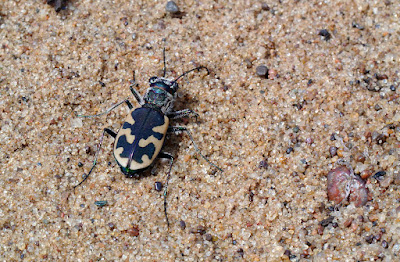"Study nature, love nature, stay close to nature. It will never fail you."
— Frank Lloyd Wright
Sheesh! I'm really getting behind on photography and blogging ...
We got nearly a foot of snow in southern Wisconsin about a week prior to the solar eclipse. Down in southern Illinois, things looked to be at least a week or two ahead in terms of flora and fauna, but we're quickly catching up. While things are greening up after some much needed rain, this past weekend the landscape was still mostly monochromatic earth tones. However, in small ways spring's vibrant colors were detectable in the form of birds, bugs, and blooms.
On Sunday, the Pheasant Branch Creek Corridor was teeming with Setophaga coronata, or "Butter-butts" as some affectionately refer to them. While the Myrtle subspecies probably won't be renamed, the Audubon variant will need to be dealt with so as not to offend. Incidentally, the ancient Greek word myrtos, from which the name "Myrtle" is derived, refers specifically to the Myrtle Plant Myrtus communis — S. coronata eats their berries (and other fruits), but they're primarily insectivorous this time of year. It was also nice to see and hear my first of spirng S. pinus and S. palmarum.
Given recent summer-like temperatures, I thought it wise to make my annual early spring trek to The Nature Conservancy's Spring Green Preserve in Sauk County for Splendid Tiger Beetles. It was very dry prior to the rain we've been getting since the outing. Naturally, I checked the rocky outcroppings for any potential buzztail dangers prior to searching for insects.
But it didn't take long to find one, the little sentinel monsters of the rocks ...
Moving in for the coveted macro close-up ...
There were Common Claybank present as well ...
What a second ... what's up with this?
From 'A Field Guide to the Tiger Beetles of the United States and Canada':
"Recent DNA studies of the Splendid Tiger Beetle, Common Claybank Tiger Beetle, and Green Claybank Tiger Beetle indicate that these arguments could be moot, as their genes are so similar they may all be one species." (David L. Pearson;C. Barry Knisley;Charles J. Kazilek.)
I observed three different copulating pairs, in each case a more bronze-colored male was either mating with or mate guarding a green-colored female.
Copulation! See the male's aedeagus (sex organ)? Ever since I first found Splendids and Claybanks together on the bluff's outcroppings at Spring Green Preserve, I thought about the possibility of interbreeding — there are notable variants; some look more Splendid than Claybank, and vice versa.
The deed is done, but now he's mate guarding ...
Male tiger beetles engage in mate guarding to ensure their paternity and reproductive success. By guarding a female after mating, a male can prevent other males from mating with her, thereby increasing the likelihood that his sperm will fertilize her eggs.
Did you know that tiger beetles can toss small rocks to injure their prey?
Just kidding. I think this beetle mistook it for something living. After a quick sampling with its mandibles, it almost immediately set it down and resumed hunting. On occasion I have observed on gusty days tiger beetles will notice small debris blowing on the surface and chase them down for mandibular inspection.
And some additional portraits ...
Nestled within the picturesque Baraboo Hills, Baxter's Hollow is a haven for ephemeral wildflower enthusiasts, offering a glimpse into the vibrant tapestry of Nature. On a recent excursion, I was captivated by the delicate beauty of Bloodroot, Round-lobed Hepatica, Yellow Trout Lily, and American Beauty. These native gems adorned the forest floor along Otter Creek, painting a scene of natural elegance.
Though not intrinsically difficult subjects, photographing wildflowers offers a unique opportunity to blend scientific observation with a deep appreciation for the beauty of Nature. In capturing the intricate details of wildflowers, photographers not only contribute to seasonal botanical documentation, but also immerse themselves in the present moment, cultivating a type of connection. Each photograph becomes a snapshot of biodiversity, highlighting the delicate balance of ecosystems and the resilience of plant life. It's especially rewarding after a long Wisconsin winter, marveling at the wonders of the natural world, fostering a deeper appreciation for the beauty that surrounds us this time of year.
And Mayapple from another location ...
And what weekend outing would be complete without a visit to the Sauk City Canoe Launch for tiger beetles?
There were hundreds of Bronzed Tiger Beetles.
But still only a few Big Sand ...
These are different angles of the same individual.
Smile, big guy!
So, that's 5 tiger beetle species already! As spring unfolds, each bird, wildflower, and tiger beetle captures a moment in Nature's ever-changing tapestry. Through photography, we preserve these fleeting glimpses and deepen our connection to the beauty and resilience of the natural world. Let's cherish these moments and continue to explore the wonders of the spring season.
All images © 2024 Mike McDowell

























































